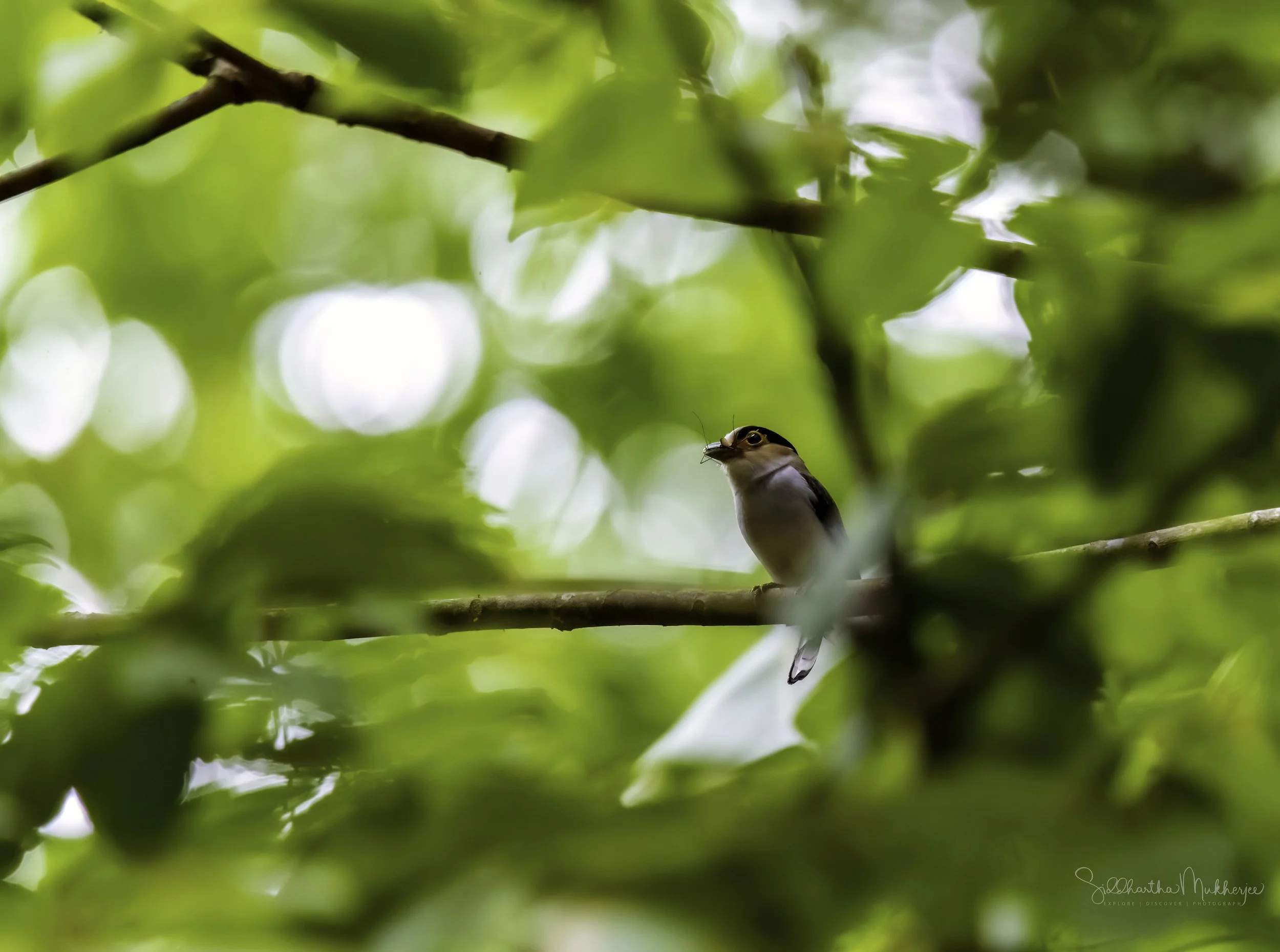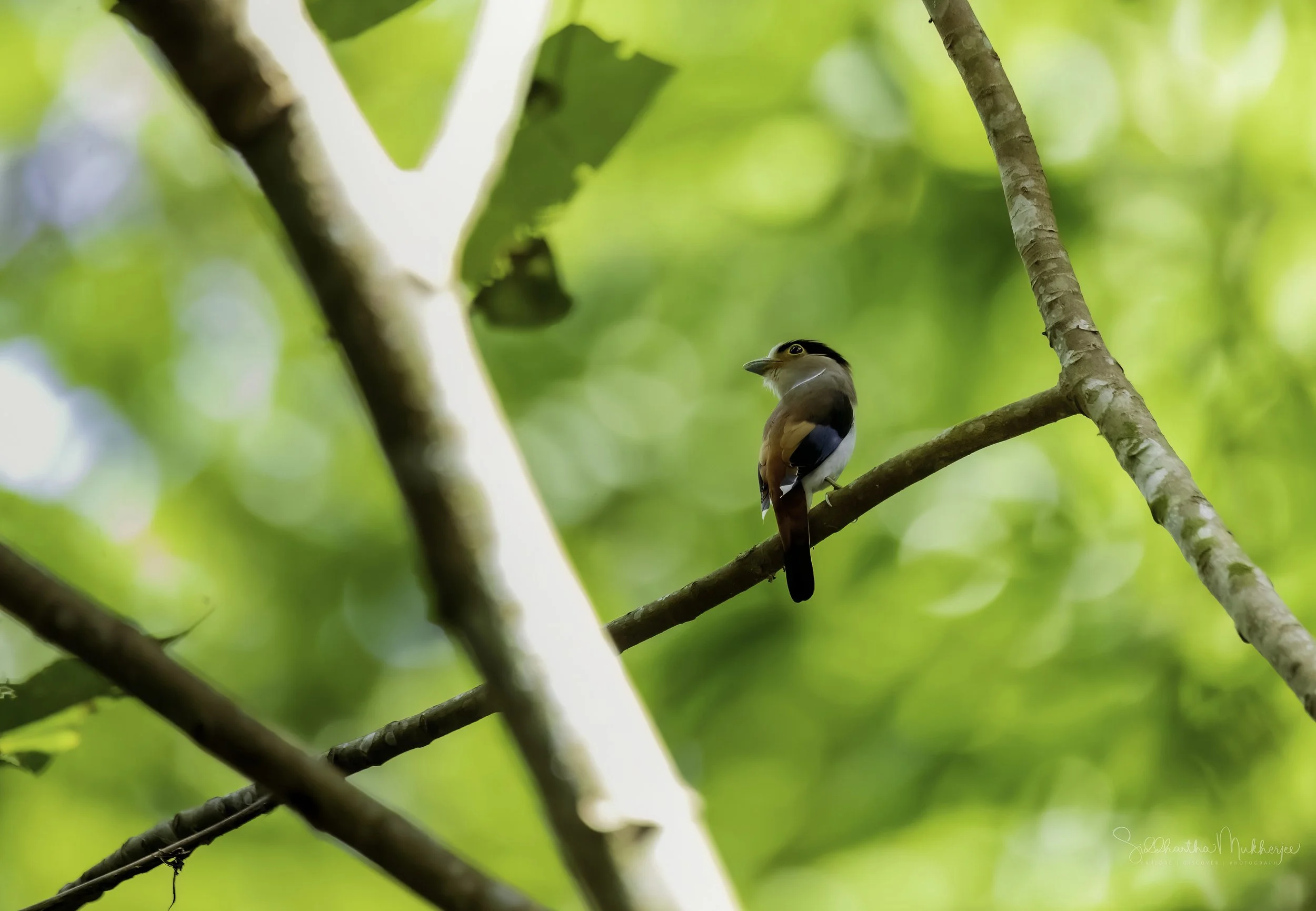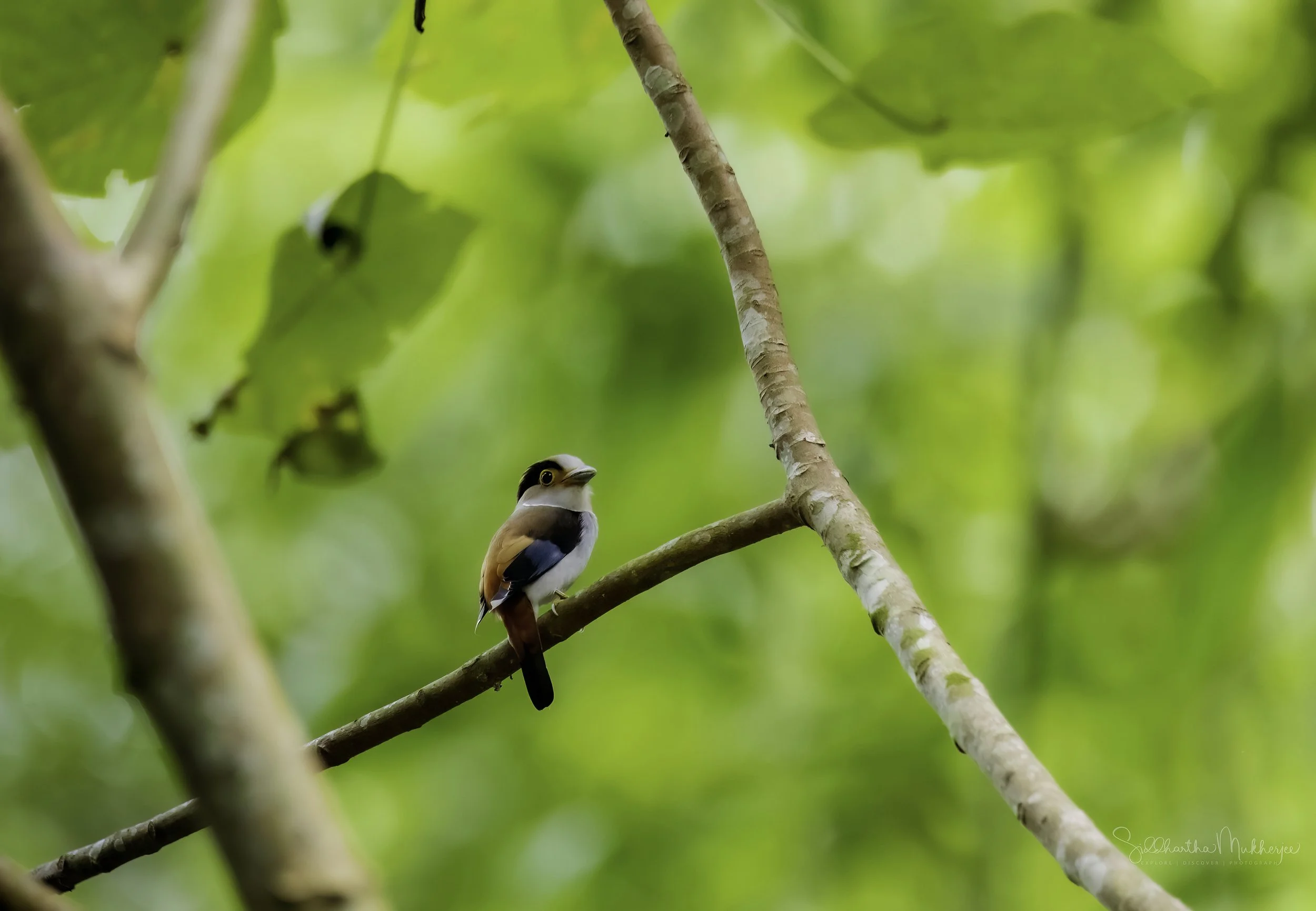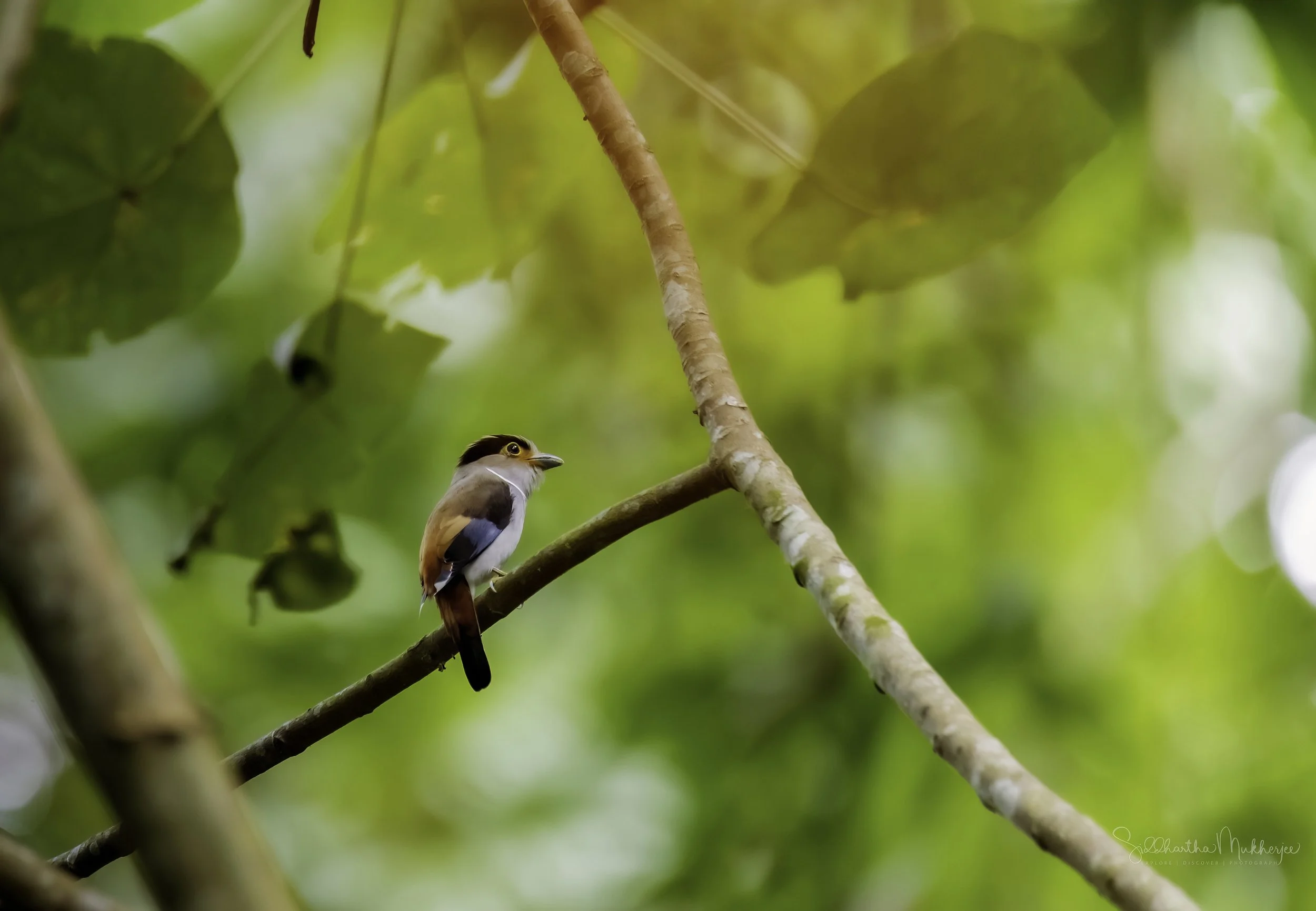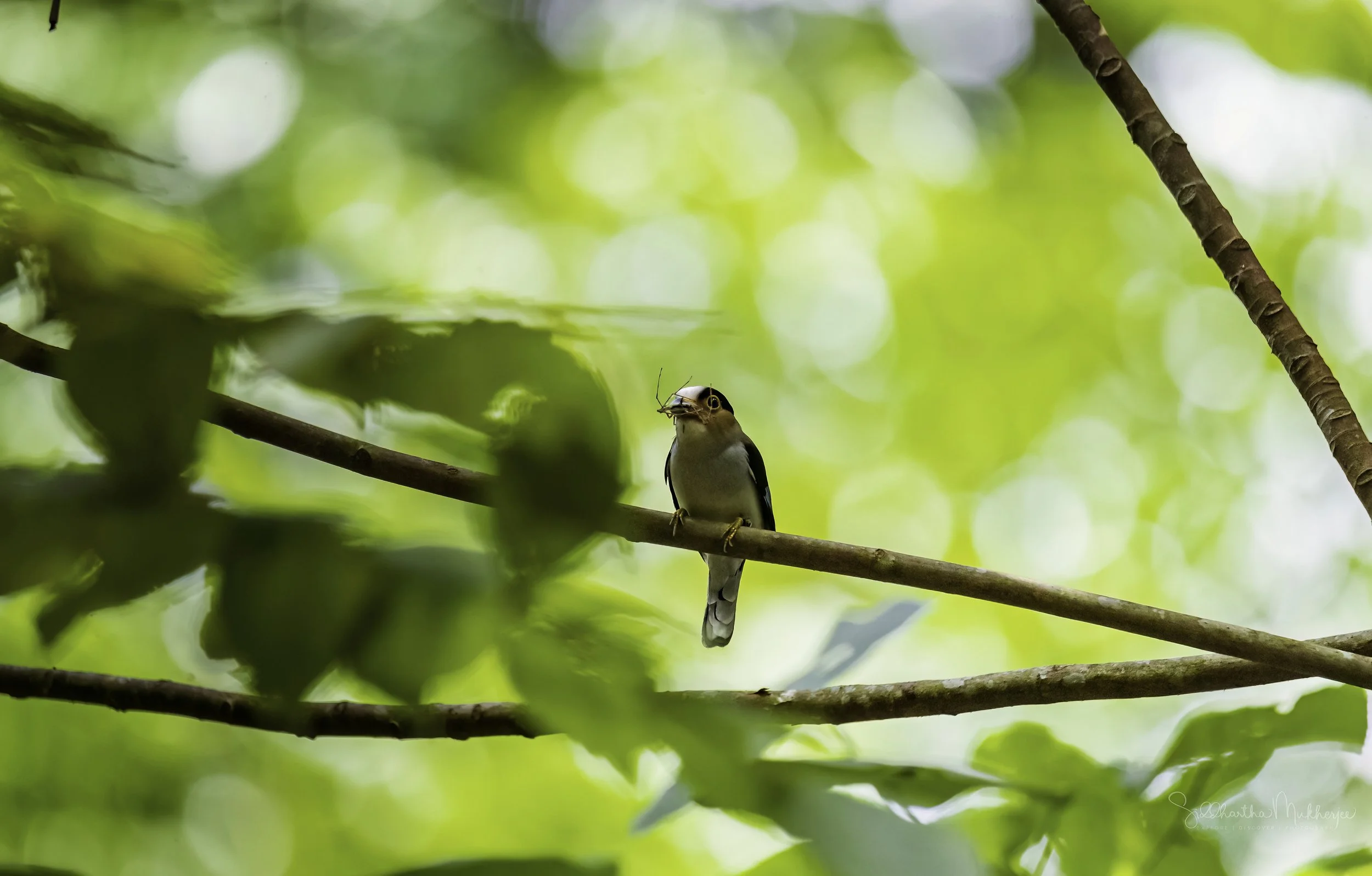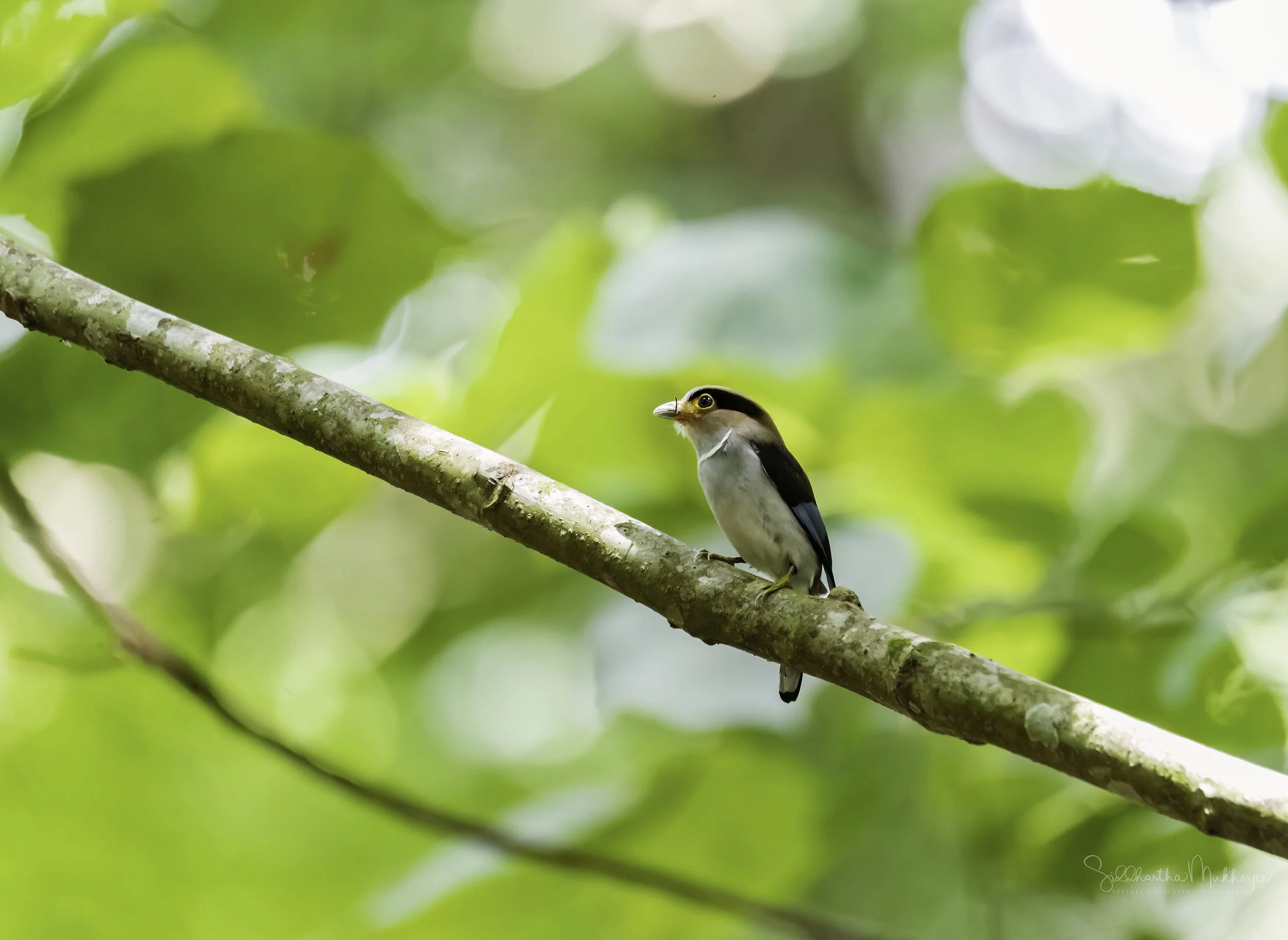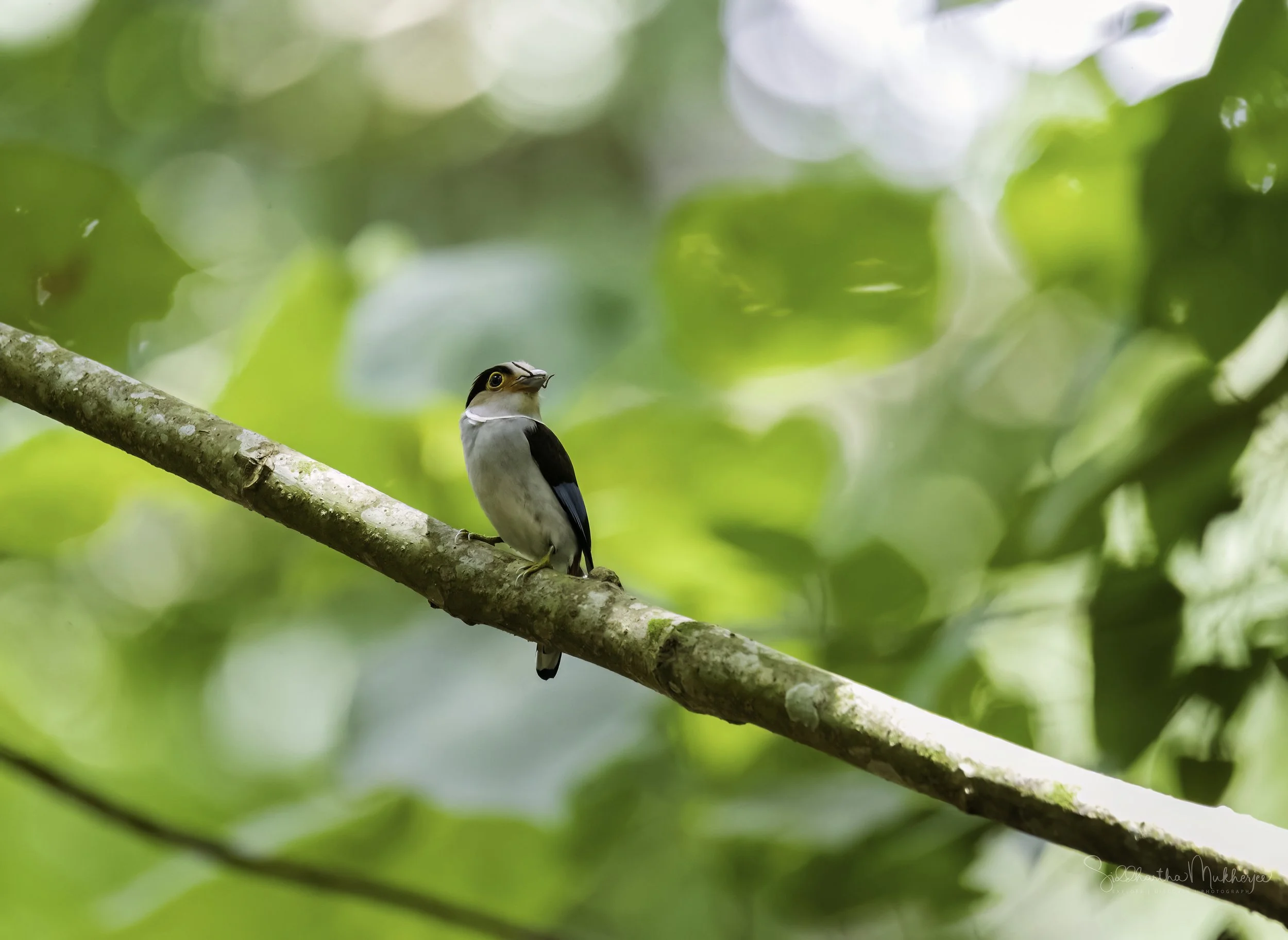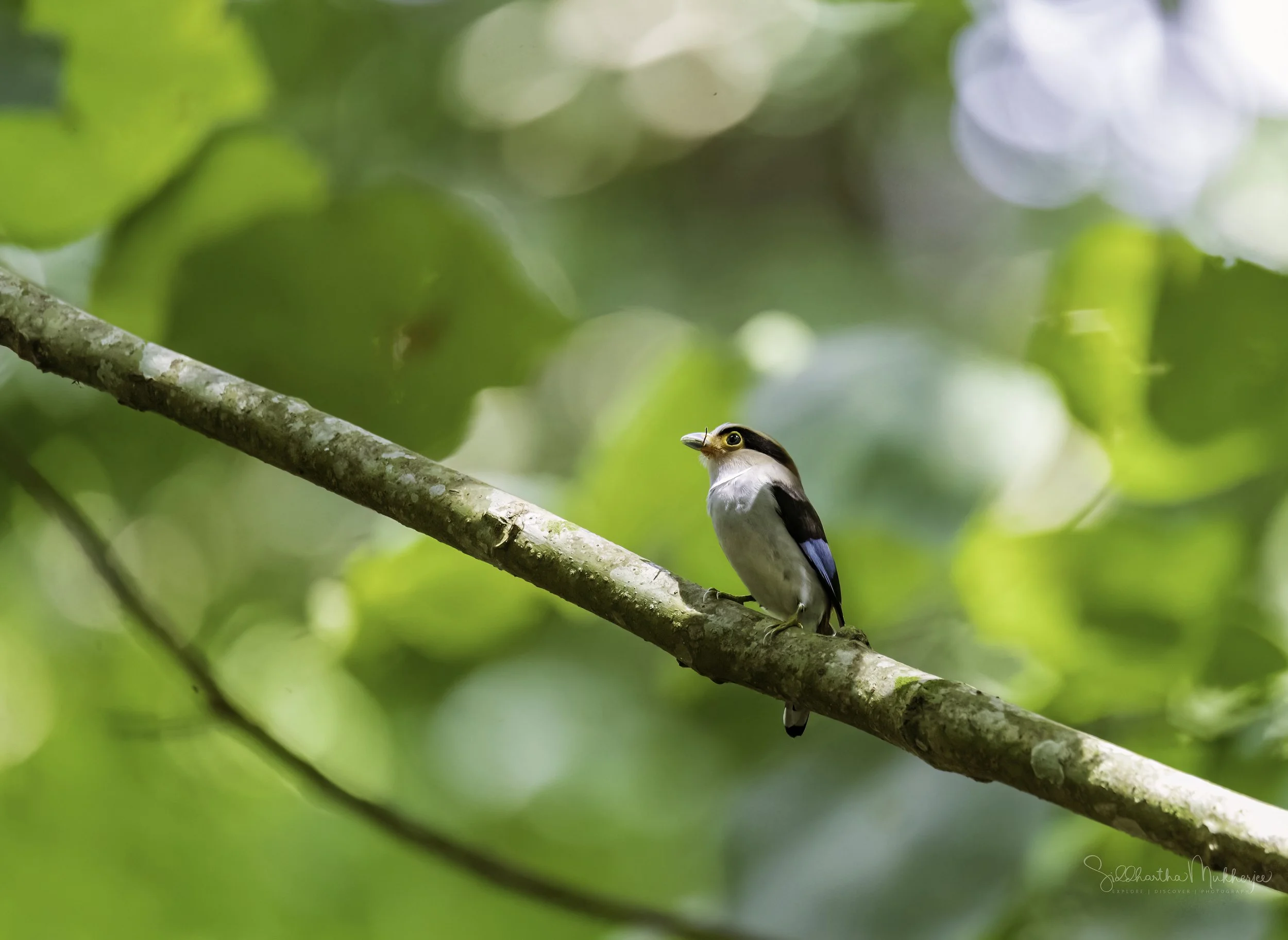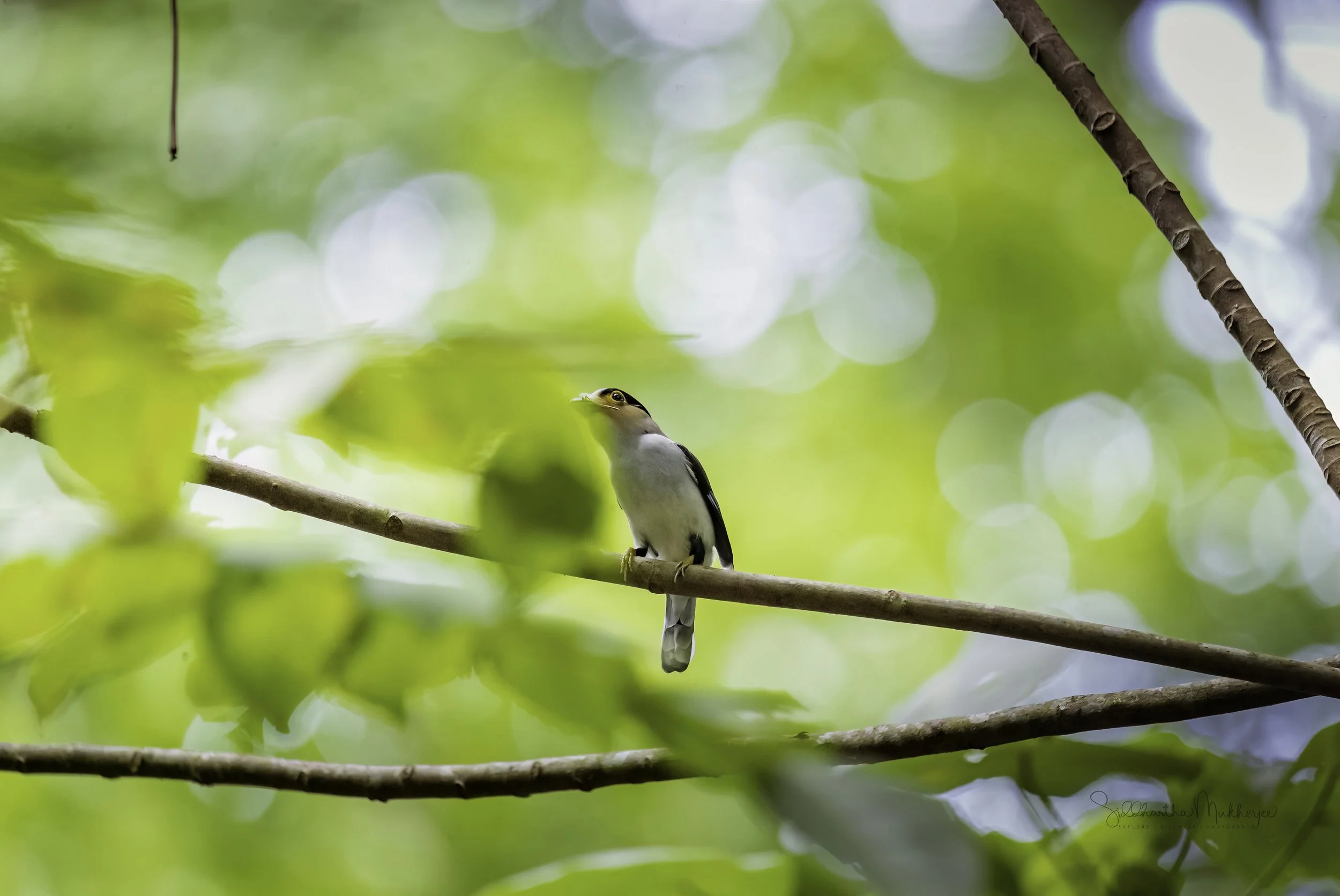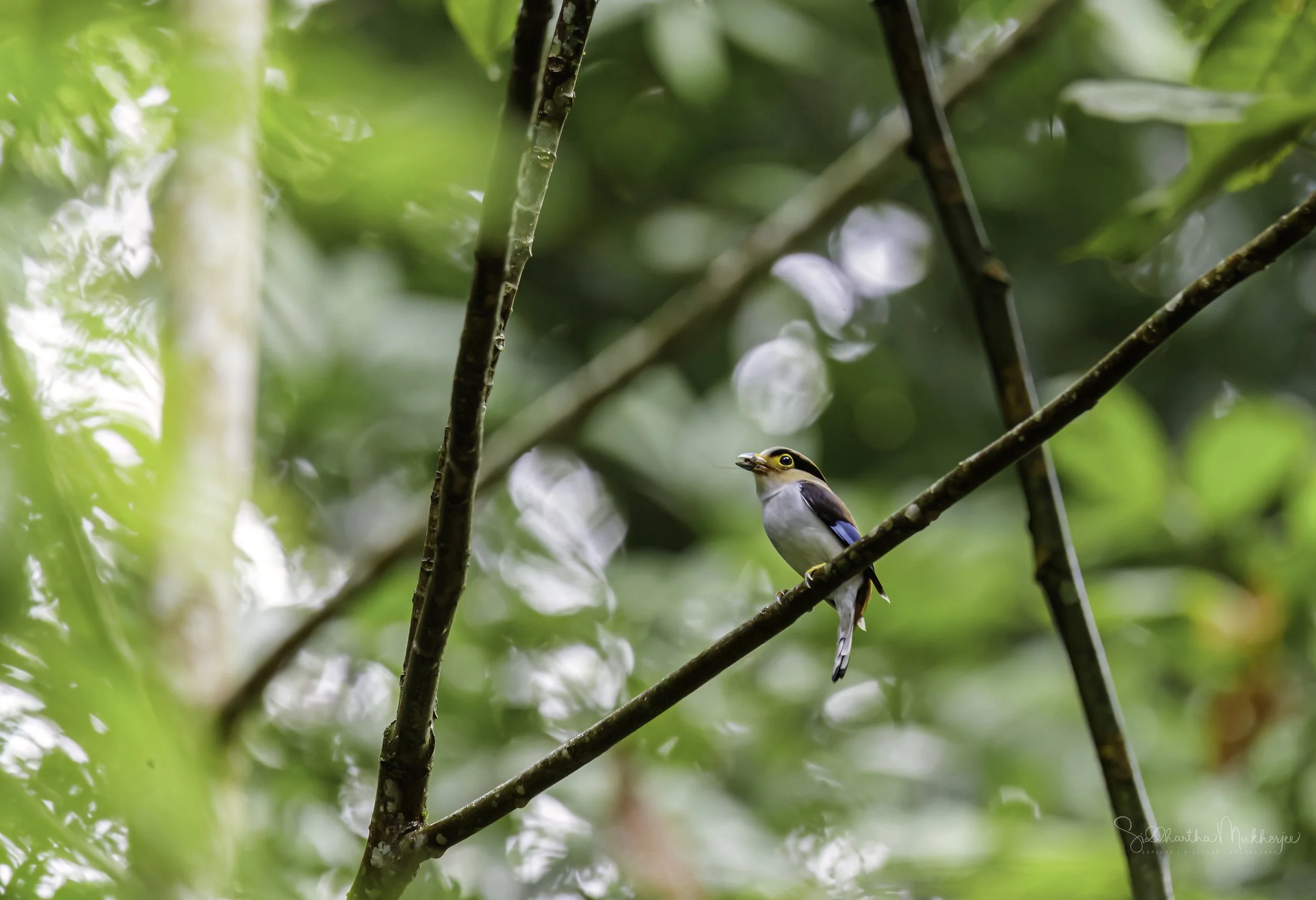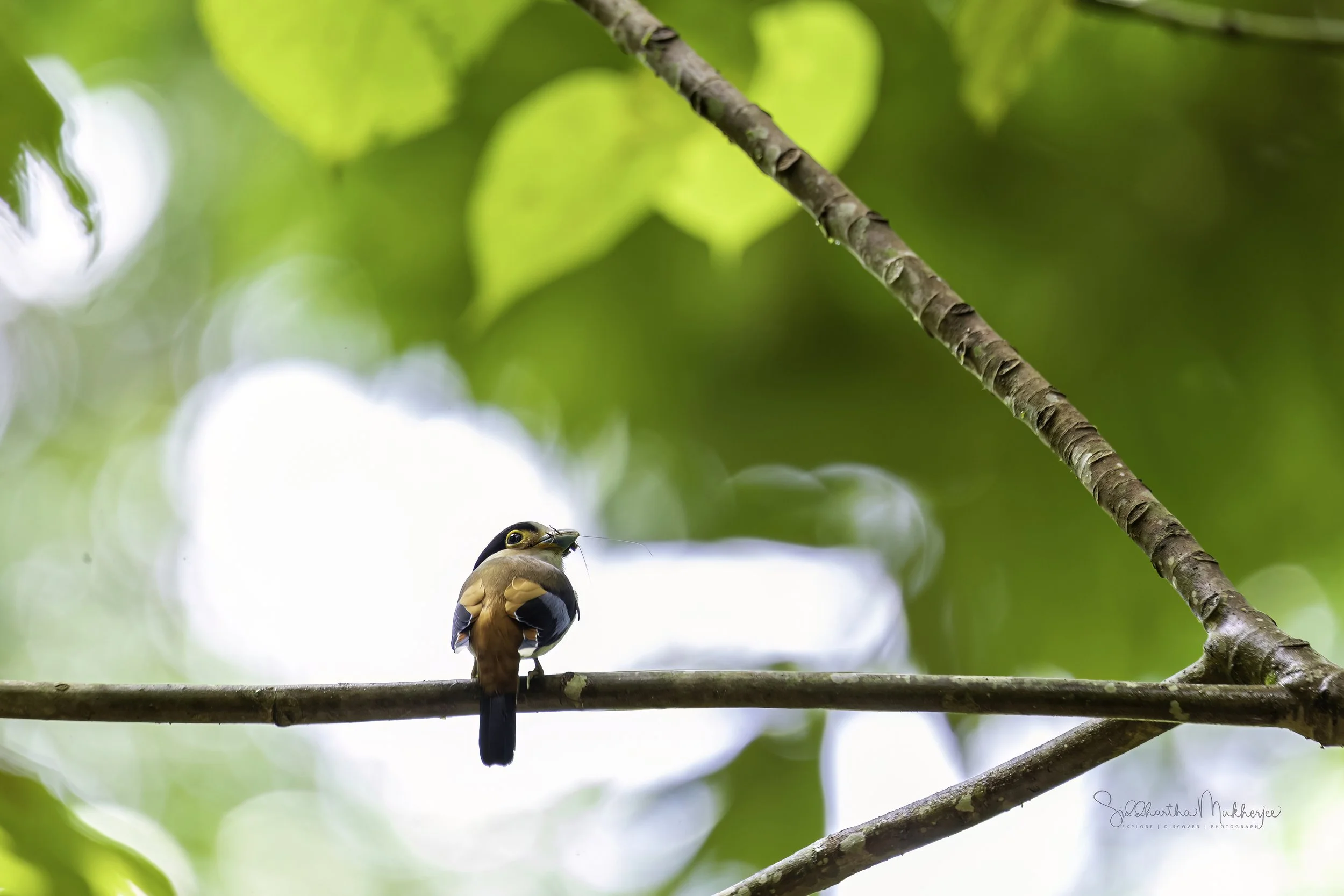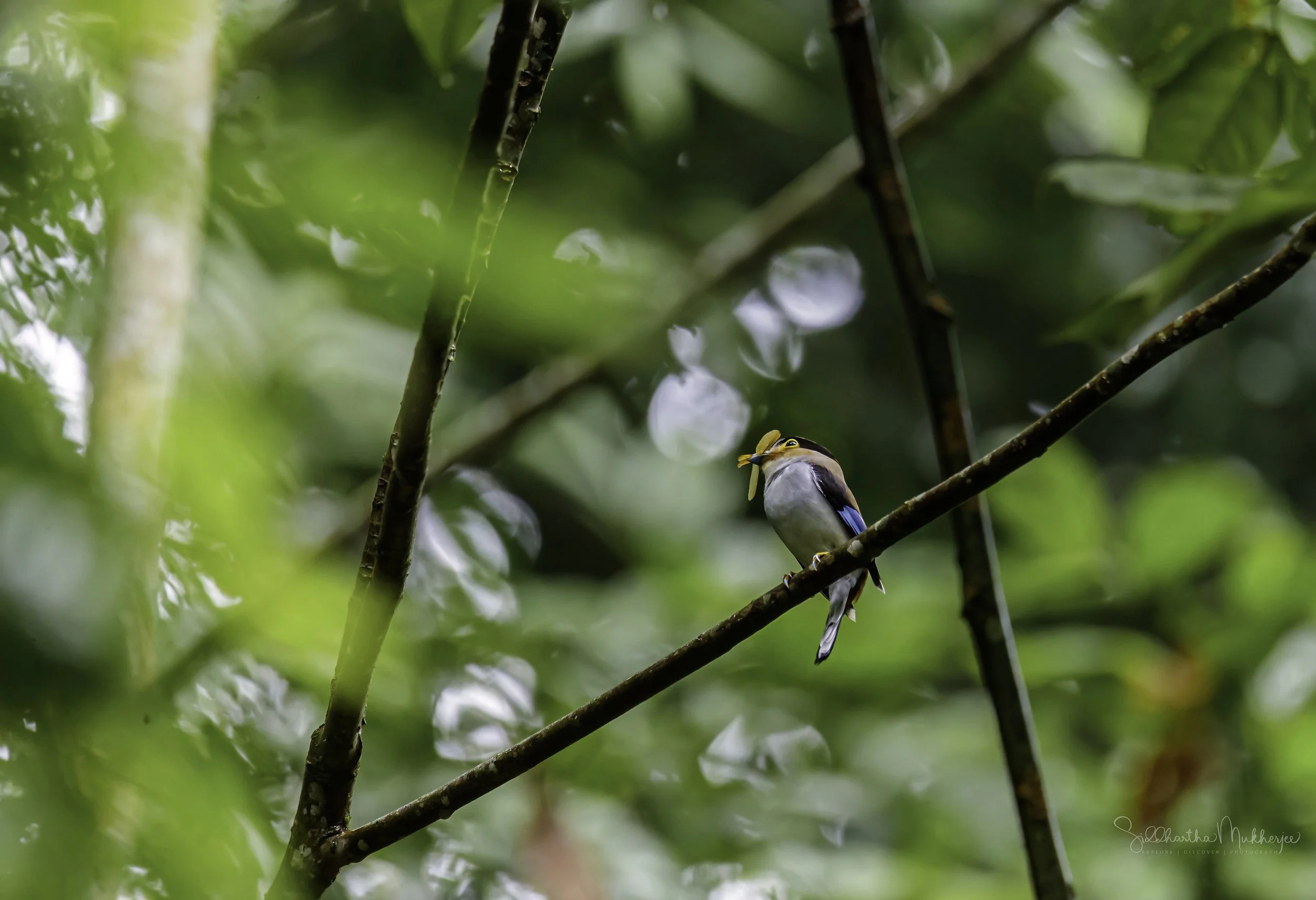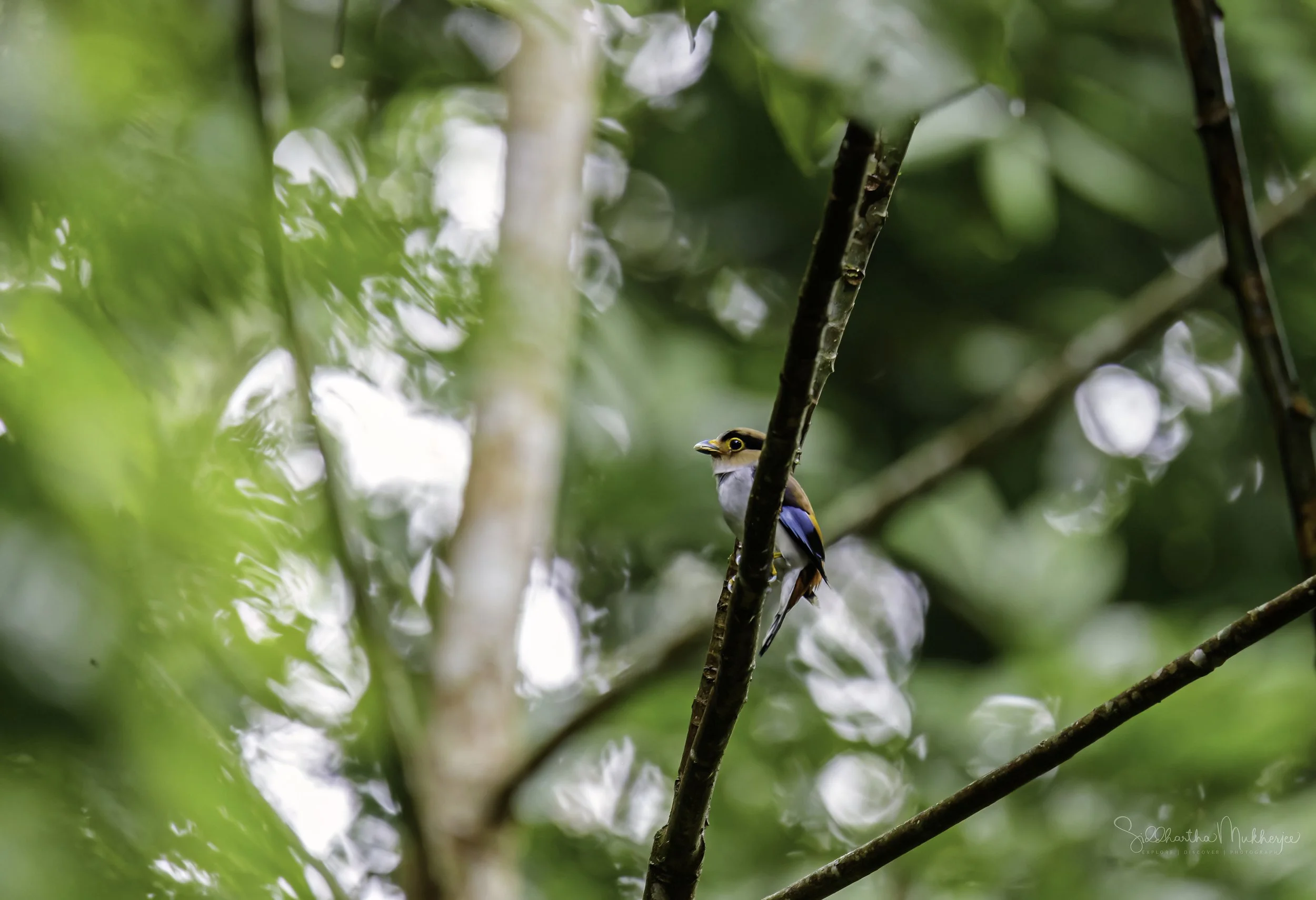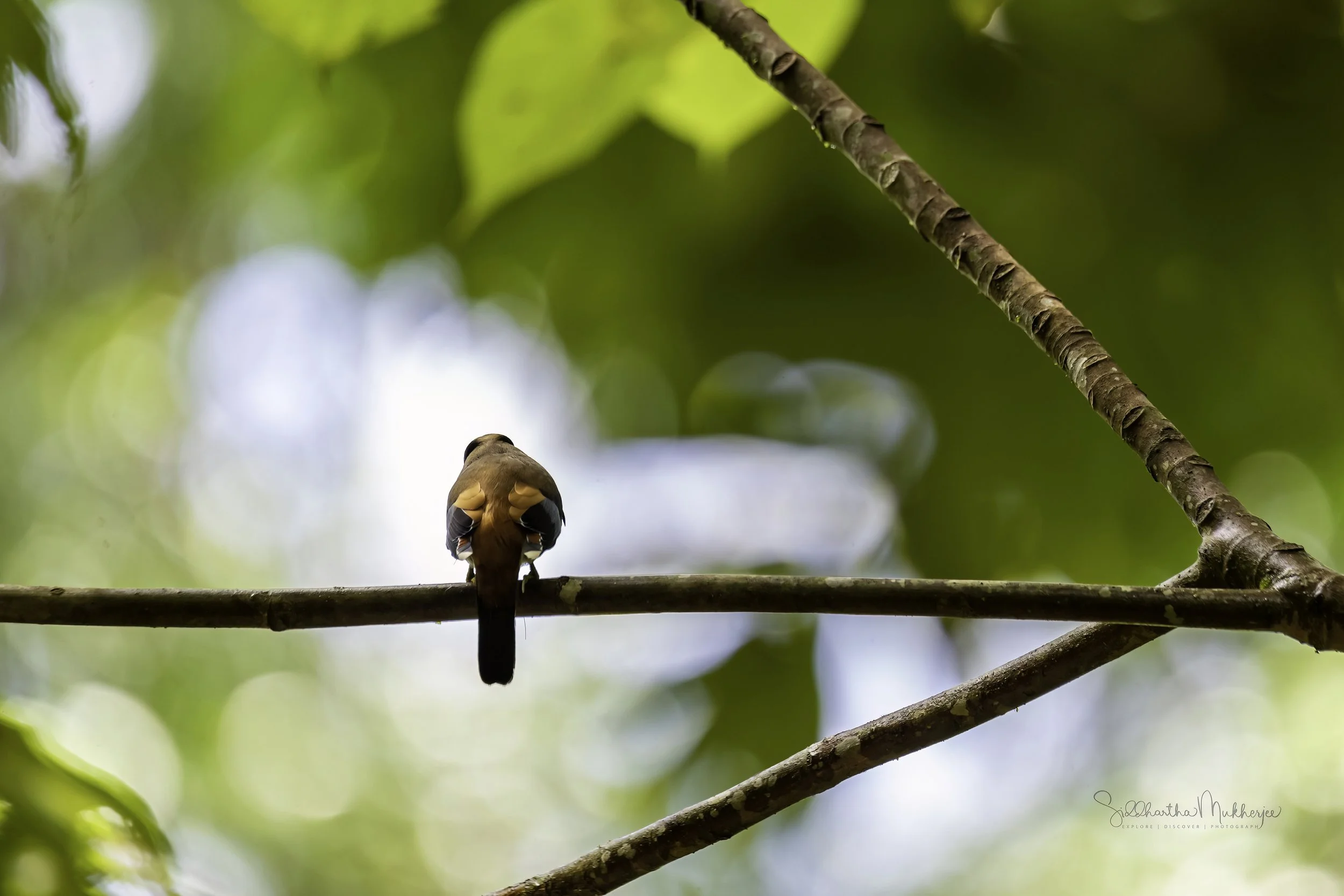Silver-breasted Broadbill
Serilophus lunatus
Kaeng Krachan National Park, Thailand
For this week I will continue with the Eurylaimidae, a family of suboscine passerine birds that occur from the eastern Himalayas to Indonesia and the Philippines. Many of the species are brightly coloured birds that present broad heads, large eyes and a hooked, flat and broad beak. They range from 13 to 28 cms in length, and live in the dense canopies of wet forests, allowing them to hide despite their brightly coloured plumage. The plumage of the juvenile eurylaimids are similar to those of the adults, differing in being duller and shorter-winged and shorter-tailed in some cases. They are for the most part insectivorous and carnivorous.
Eurylaimids feed on a broad variety of insects and invertebrates, especially large orthopterans and mantids, as well as small vertebrates (frogs, lizards, and even fish). Exceptionally, Grauer’s Broadbill (Pseudocalyptomena graueri) appears to be primarily frugivorous. Most broadbills acquire food by gleaning or during short sallying flights from perches. I have talked about these birds earlier as a collection and one specific Near Threatened species, the Banded Broadbill.
There are four subfamilies of broadbills: Smithornithinae (typical African broadbills), Calyptomeninae (Asian green broadbills), Eurylaiminae (assorted Asian broadbills) and Pseudocalyptomeninae (Grauer’s broadbill). There are 9 genera and 14 species of broadbills. They are thought to be closely related to pittas (Pittidae) and asities (Philepittidae). They are primarily forest birds and live in rainforests of tropical Asia and Africa. Little is known about the mating behaviour of this group. Some species are thought to be monogamous, others polygynous and some may be cooperative breeders. During displays, many broadbills make a loud trilling sound with their wings that can be heard up to 60 m away. Most species are gregarious. Some species eat primarily insects while others mainly eat fruit. Here we will see one of the Eurylaiminae (assorted Asian broadbills).
The strikingly patterned broadbills of Asia are forest canopy birds, often revealed only by their throaty staccato calls. The bold contrasting swatches of black, yellow, and red or green in their plumage often extend into a very large and brightly coloured blue or silver bill, creating a visual impact to equal that of any other passerine in these forests. Their distinctive baglike nests are suspended by a long vine or tendril far beneath overhanging branches, and often over water or near a bee or wasp nest to protect the nest from tree-bound predators. As with the green broadbills, these Asian birds have a cousin in Africa with very different appearance, but we know very little about it.
They attach their purse-shaped nests to suspended vines, and leave a tail of fibres hanging below it. This gives the nest the appearance of being random debris caught in the tree, an effect further enhanced by the birds covering the nest with lichen and spider webs. Talk about camouflage! I have a photo of the silver-breasted on its nest later.
Based on banding recaptures, broadbills are estimated to live at least 6 years in the wild. The oldest recorded bird in captivity was 19 years old.
‡‡‡‡‡
Conservation: Six out of 15 species are on the IUCN Red List. Three species are considered Vulnerable and three Near Threatened. With no more than 10,000 individuals each, the vulnerable species all have tiny ranges that are threatened by deforestation, mining activities, and/or guerilla warfare (on Mindanao, Philippines). Deforestation of lowland forest threatens Hose's, White-head's and Black-and-yellow (Eurylaimus ochromalus) broadbills.
Large areas of the wooded habitats of Asia have been harvested or converted to agriculture, creating conservation concerns for four (44%) eurylaimid species (1 NT, 3 VU). The three vulnerable species occupy very restricted ranges in the Philippines or in the Albertine Rift mountains of Africa, and the near-threatened species is limited to three areas in the Malay Archipelago.
‡‡‡‡‡
Read more about the other Broadbills I have photographed.
‡‡‡‡‡
Kaeng Krachan National Park
Kaeng Krachan National Park is located in Phetchaburi and Prachuap Khiri Khan Provinces, about 60 km from Phetchaburi and 75 km from Hua Hin. It is bounded by the Tanintharyi Nature Reserve along Myanmar's border to the west and part of the Western Forest Complex that covers 18,730 km² across 19 protected sites between Myanmar and Thailand. There are two main rivers in the park; Phetchaburi and Pran Buri Rivers. Both rivers originate from the Tanaosri Mountain Range. In the north, Phetchaburi River flows into Kaeng Krachan Dam and flows further east all the way out to the Gulf of Thailand. Pran Buri River flows south to Prachuap Khiri Khan Province, into Pran Buri Reservoir and out to the Gulf of Thailand.
The highest elevation in the park is a peak along the Burmese border at around 1,500 meters. The park is popular for wildlife which doesn’t necessarily mean it is easy. The possibilities depend on the seasons and seasonal conditions for various types of animals. Mammals like leopards, clouded leopards, bears, stump-tailed macaques, sambhar, barking deer, elephants, dholes, golden jackal, gaur, serows, crab-eating mongoose and tapirs can be spotted in the park. There also used to be a significant tiger population in the park up until a decade ago, but only a few are left now.
Langurs, stump-tailed macaques, white-handed gibbons, sambar, mouse deer, porcupines, monitor lizards, civets and black giant squirrel are frequently seen. White-handed gibbons can be seen or heard nearly every day, often seen at the edge of the campsites.
On this trip I was hiking up the stream called Pran Buri deep in the Kaeng Krachan National Park and about 2 kilometers further up from the Ban Krang Campsite on the way to the Phenoen Thung Viewpoint and further to the Tho Thip Waterfall when I spotted the beautiful Silver-breasted Broadbill. There was a pair of them there and also a nest.
Silver-breasted Broadbill (Serilophus lunatus)
The Silver-breasted Broadbill (Serilophus lunatus) is a species of bird in the broadbill family, Eurylaimidae. It is monotypic (the only species) within the genus Serilophus. There are ten currently recognised subspecies, one of which, rubropygius, was formerly treated as a separate species.
Found in Bangladesh, Bhutan, Cambodia, China, India, Indonesia, Laos, Malaysia, Myanmar, Nepal, Thailand, and Vietnam its natural habitats are subtropical or tropical moist lowland forest and subtropical or tropical moist montane forest. The species has declined somewhat due to habitat loss, but is not considered to be threatened with extinction.
A small quiet bird with a distinctly silky, smooth-feathered appearance. Pale below and warm soft brown above with a black crescent above the eye and a glossy blue patch on the dark wings. It usually moves around through the middle layers of foothill and montane forest and does not often join mixed-species foraging flocks, instead tending to stick to medium-sized groups of its own species.
It is a medium-sized broadbill, averaging around 16–17 centimetres in length and weighing between 25–35 grams. The plumage of the nominate race has a rusty-coloured head with an ash-grey forehead and a broad black supercilium (stripe) over the eye. The breast and belly is white and the rump and upper wing coverts are bright rufous. The flight feathers are striking blue and black and the tail is black. There is a small amount of sexual dimorphism in the plumage, with the female having a narrow silver band across the breast. Young birds resemble adults but with shorter wings and tails, and slightly darker plumage overall.
There is also some variation across the different subspecies which are are distributed in China, Myanmar, Thailand, Vietnam, Laos, Malaysia and Indonesia. Vagrant birds have been observed in India.
Range of the banded broadbill; nominate subspecies in light green and other subspecies in dark green
The nominate subspecies S. l. lunatus is distributed in south and southeast Myanmar and northwest Thailand
The subspecies S. l. intensus is distributed in Sumatra (Indonesia).
The subspecies S. l. rothschildi is distributed in extreme south Thailand & peninsular Malaysia.
The subspecies S. l. impavidus is distributed in southern Laos, the Bolaven Plateau.
The subspecies S. l. aphobus is distributed in Cambodia and southeastern Thailand.
The subspecies S. l. stolidus is distributed in southwest and south Thailand and south Myanmar.
The subspecies S. l. atrestus is distributed in central and east Myanmar, northeast Thailand, central and south Laos, northwest Vietnam and south China (Yunnan).
The subspecies S. l. polionotus is distributed in Hainan (China).
The subspecies S. l. elisabethae is distributed in distributed in southeast China and north and central Vietnam.
These silver-breasted broadbill species have moderate forest dependence and normally occur in altitudes from 300 to 2000 meters. The natural ecosystems of these broadbill species include tropical and subtropical moist lowland forests, evergreen forests, tropical and subtropical moist montane forests, semi-evergreen forests, bamboo forests and deciduous forests while the artificial ecosystems of these species include agricultural fields and rural gardens. Their diet consists mainly of insects and a variety of invertebrates and their larvae, grasshoppers, mantises, caterpillars and small land snails. They also hawk flying insects from a perch and by gleaning them from tree branches.
Silver-breasted Broadbill - Nesting
The breeding season of the silver-breasted broadbill species is from March to August. These birds are monogamous. The nest is hung from the tip of a tree branch with an average height of two meters above the ground. The nest is a bulky untidy ball of twigs with a lateral entrance. Both birds take part in nest construction and the clutch contains 3 to 5, glossy, white, oval shaped eggs laid with an interval of one day.
The silver-breasted broadbill species are non-migratory resident birds. Birds in higher elevations may move to lower elevations and plains in the winter. Post breeding, the juvenile broadbills may disperse and establish in new locations within the range. They may make local movements for feeding and breeding within their range.
The global population size of the silver-breasted broadbill (Serilophus lunatus) has not been quantified. The overall population trend of these species is reported to be decreasing. Throughout its range this broadbill species is reported to be locally common to uncommon. Deforestation, habitat degradation and fragmentation and capture of adults and juveniles for pet trade are the main threats that may endanger the survival of these broadbill species. The silver-breasted broadbill (Serilophus lunatus) does not approach the thresholds for being Vulnerable, either under the range size criterion, or under the population trend criterion or under the population size criterion. The IUCN (International Union for Conservation of Nature) has categorized and evaluated the broadbill species and has listed it as of "Least Concern". The CITES (Convention on International Trade in Endangered Species of Wild Fauna and Flora) status is ‘Not Evaluated’ for silver-breasted broadbill (Serilophus lunatus).
With that said, let’s move onto the gallery of this pretty bird.
‡‡‡‡‡
Related Posts

